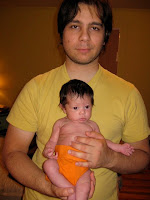Not surprisingly to any natural childbirth advocates, the national birth rate fell by 3 percent less than 2008 with a birth rate of 4,247,694 in 2009, compared with 4,131,019 in 2008. Is it any wonder that it fell?! It is a fact that many women are actually choosing to forgo having another baby due to the fear of having a repeat Cesarean Section. Add to that fact that many women who do decide to have another baby after a C/Section suddenly discover that they are incapable of getting pregnant again naturally, because the surgical scar can cause infertility problems. When as many as 1 in 3 women suffer from fertility problems after a C/Section is it any wonder that the American National Birth rate is falling?
Last February it was announced that having a VBAC birth (Vaginal Birth after Cesarean Section) was actually safer than they originally thought, especially for women with multiple uterine scars. BJOG ( an International Journal of Obstetrics and Gynaecology), found that women with 3 previous Caesarean Sections have similar outcome rates of success as women with only one previous Caesarean section in a study of 25000 women attempting a vaginal birth after a Ceasarean section. The study shows that not only did the women with 3 previous C/Section uterine scars have a very similar rates of success in having a VBAC birth, but that the rates of morbidity were also very similar between the women that had a VBA3C and those that chose to be delivered by elective repeat caesarean. A few month later ACOG made an official announcement that:
ACOG states that VBAC is a safe and reasonable option for most women, including some women with multiple previous cesareans, twins and unknown uterine scars. ACOG also states that respect for patient autonomy requires that even if an institution does not offer trial of labor after cesarean (TOLAC), a cesarean cannot be forced nor can care be denied if a woman declines a repeat cesarean during labor.
Shall we gather here again at this time next year to see if the new official party line has had any effect at all on the rising Cesarean Section rate? Are you holding your breath? Me neither.
ACOG can make all the grand pronouncements they want, but if the hospitals and Doctors and Midwives don't listen and change their policies accordingly, then it's all just a waste of the paper that the studies were printed on.
After I wrote: "New ACOG guidlines for VBAC births"- I sat at the computer and once the initial high of elation had worn off, I had a bit of a sad. I stared at the words on the screen and thought to myself "how many women out there are reading this news with a sense of unbearable sadness for the births they didn't have. Couldn't have. Because last week these people and their grand pronouncements said they couldn't." Five months ago I fought tooth and nail, and had to signed a stack of waivers pretty much as tall as my eldest son, to have a VBAC birth. And I live in Canada and have the good fortune to have a Charter of Rights that gives me the legal Right to refuse a surgeons knife, I can't imagine how my American sisters feel.
We, the women and mothers, have been telling them for years. We have been in a ridiculous battle against the "powers that be" to be able to birth our babies OUR way. To follow our intuition and allow ourselves the dignity of choosing where, when and how we will give birth. It has ALWAYS been OUR births. We shouldn't of needed a big green light from a commercially motivated "association" (just another word for "corporation") to tell us this- to allow this to be denied to hundreds of thousands, if not millions, of mothers!!
Mama Birth said it so well in her article "ACOG Still Sucks"
Thousands of women have fought, bled and died for this change to come about. They have gone through the stigma of birthing at home in order to have a birth that they chose. They have been attended by supportive midwives. Some of them have birthed unassisted. Some of them have had hospital births in hostile environments where they were disrespected but in the process have shown hospital staff that VBAC is possible.
These are the women who deserve the praise for this recent statement.
Not ACOG. To ACOG I want to say this:
What can you do for all of those women who were denied VBAC because of you? Can you remove their scars? Can you remove their fears? Can you give them their births back? Can you change what you have already done?
You can do none of these things. Thousands if not hundreds of thousands of women have already suffered at your hands. Many more will because of the refusal of many OB's within your community to even acknowledge these new recommendations. You can not fix the pain that you have caused.
Thank you ACOG for changing your policy.
Shame on you for all of the bad births, scars, pain, depression and death that have come at your hands because of your unwillingness to do this sooner.
So will the leopard change it's spots? Will the American national Cesarean Section rate fall for this year? Maybe next year? Yea, I'm definitely not holding my breath on this one.







